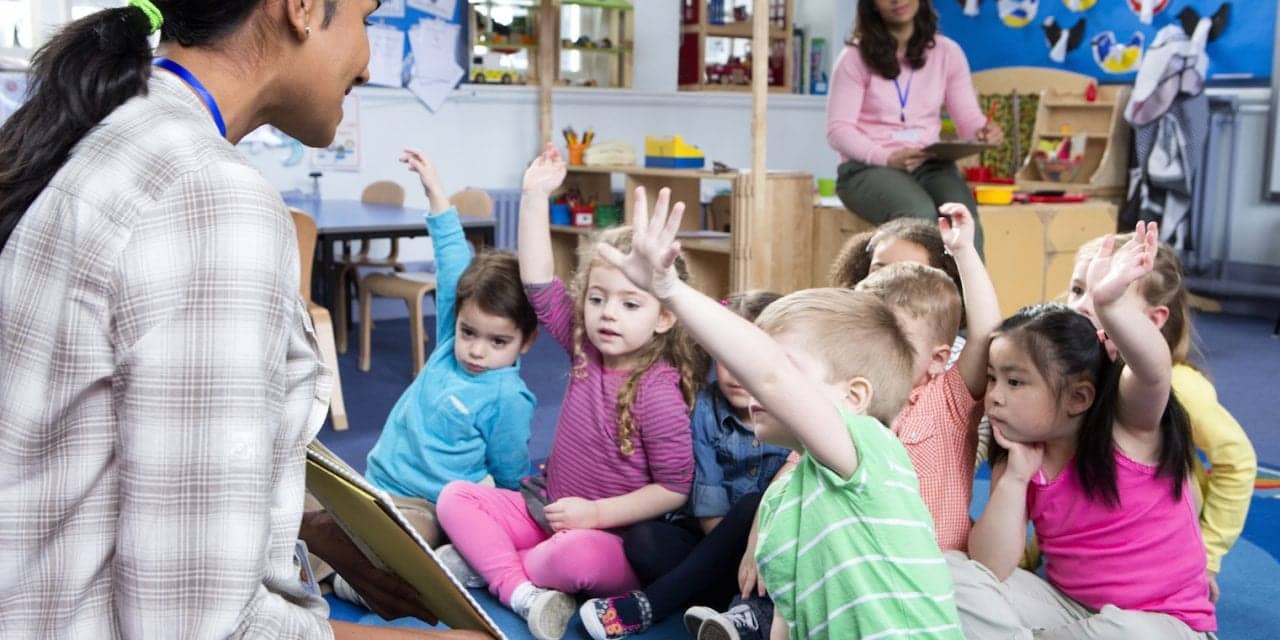Tech Topic | September 2018 Hearing Review
Should noise reduction algorithms be used in pediatric hearing aid fittings? Here is an examination of the rationale and arguments from the literature which generally support the use of advanced noise-reduction techniques and technologies for children.
Pediatric and adult amplification have similar, but different, goals. The similar goals include maximal audibility of speech sounds, an increased signal-to-noise ratio (SNR), reliable and easy-to-use functionality, and an assurance that sounds are, and remain, comfortably loud, while not exceeding uncomfortable loudness levels UCLs. Unique pediatric concerns include delivering maximal, precise, appropriate speech sounds, optimized to facilitate intentional and incidental learning, through intentional and incidental hearing.
However, in tandem with delivering a complete complement of primary speech sounds, it is necessary to reduce secondary background noise. That is, to facilitate hearing, listening and learning, we should endeavor to provide maximal audibility of acoustic speech sounds while reducing background noise, so as to present the best possible SNR to the listener.
Unfortunately, although adults and children are often challenged to understand speech in noise, children’s environments are typically noisier than those of adults. Children with hearing loss are known to require higher SNRs than adults to achieve similar speech recognition scores (eg, see Neuman et al,1 Nittrouer & Boothroyd,2 Papso & Blood,3 and Schafer et al4), rendering pediatric amplification more challenging, as we facilitate successful intentional and incidental hearing, to better develop speech, language, and auditory skills.
In this article, we will examine the rationale and the arguments associated with applying noise reduction in pediatric hearing aid fittings, and we’ll present citations, observations, and research which support the use of advanced noise reduction techniques and technologies in pediatric hearing aid fittings.
Incidental Learning in Children with Hearing Loss
Incidental learning is learning which occurs while focusing on something else. Incidental learning occurs in the absence of an intent to learn. As such, everyday learning is both incidental and intentional. Incidental learning and listening happen all the time for children with normal hearing. Indeed, parents and caregivers may sometimes wonder “Where did she learn that?” Incidental learnings might be triggered by a simple phrase, concept, or idea which the child unintentionally observed and learned simply by being exposed via proximity.
Madell and Flexer5 report the audiologist has a role and responsibility to assure that children benefit from varied academic and social learning environments. They report acoustic access to classroom information is absolutely necessary, and therefore the child’s hearing technology and the classroom acoustics need to be monitored. Further, children with hearing loss need early identification, early and optimally fit hearing technology (through at least 8000 Hz), full-time use of hearing technology (10 hours minimum/day), remote microphones in all learning environments (in and out of school and at home), auditory-based family therapy, family support, a rich language and rich information model, opportunities to learn, and educational programs which make necessary adaptations to maximize learning.
Unfortunately, sometimes there are no educational audiologists available. In that situation, the responsibility for acoustic access to foster incidental learning falls on the clinical audiologist. In these cases, the clinical audiologist has a substantial challenge, as they are not located in or near the classroom. Further, they must assure the technology is working properly, is appropriate for the situation, and that sound is maximally audible for quiet and normal speech in quiet and noise.
Noise Reduction in Pediatric Amplification
In the American Academy of Audiology (AAA) Clinical Practice Guidelines on Pediatric Amplification,6 it is stated that the ultimate goal of pediatric amplification is to “maximize the opportunities for the child to develop age-appropriate receptive and expressive oral communication, language development, literacy skills, and psychosocial skills.” Compared to adults, the acoustic environments and the developmental and listening needs of children are unique. Therefore, the prescription of digital noise reduction (DNR) should be applied to reduce annoyance and increase hearing aid acceptance in noisy environments, without the DNR having a negative impact on speech recognition ability in children.
To complement the recommendation of the guidelines, Scollie et al7 developed a clinical protocol for verification of noise management signal processing. This further highlights the needs and importance of applying appropriate noise reduction technologies in pediatric amplification. Admittedly, digital noise reduction is not universally applied in pediatric fittings due to fear of hampering incidental learning. However, in 2018, there is a preponderance of evidence indicating the advantages associated with DNR outweighs the potential theoretical disadvantages.
Beck8 stated “modern hearing aid technology is so good that audiologists and dispensers should use noise reduction and directional microphones for children of all ages, just like adults!” This declaration was not universally embraced, and indeed, some considered it rather controversial. However, Dillon proffered some pediatric audiologists had adopted the position “let’s not do anything for children until and unless it’s proven beneficial with children, because children are different.”8 Yet, the differences do not automatically indicate that whatever might be a proven benefit for adults is not good for children. For example, throughout medical history, there was a first child who received eyeglasses, contact lenses, antibiotics, hand, arm, leg and foot prosthetics, heart transplants, cochlear implants, and more—all following successful trials on adults.
In another interview for the American Academy of Audiology (AAA),9 Madell stated she believed in using digital noise-reduction (DNR) circuits for children, because DNR circuits are known to make sounds more pleasant. With regard to directional microphones, she advocated their use in children, after their first birthday, or once the child develops the skill to turn their head to face the sound source.
Likewise, Beck10 stated the outcomes and technical improvements within digital hearing aids have been very dramatic. In response to the question “Do you think we should use advanced, top-shelf, intelligent automatic hearing aid features, such as digital noise reduction, adaptive directionality, and extended bandwidths for all children (with appropriate hearing loss, such as mild-moderate-severe sensorineural hearing loss) most or all the time?” Northern replied:
“…The few studies in the contemporary literature indicate these smart technologies can be used by children, just like adults, and they are likely beneficial. Frankly, I cannot imagine denying children access to these important amplification features. We cannot do extensive research with these advanced features in young children as we really don’t have sufficiently sensitive tests to document differences in functional performance. However, when these features are well-fitted with best practice protocols, and are verified and validated, they may increase speech recognition in adults. Most importantly, use of these features does not negatively impact speech perception in adults. So yes, it seems to me, they should be used for children unless there is a clear contraindication.” 10
Noise Impairs Speech, Language, and Learning
Noise has detrimental effects on speech understanding and learning in children.11 Learning typically takes place in environments, such as busy and noisy classrooms with elevated noise levels and less-than-ideal SNRs.12 Further, with regard to speech production, words learned in noise are often less accurately produced than words learned in quiet.11 That is, noise impacts the quality of word form representation in the lexicon of the newly learned words. More exposures or repetition of words would be needed before an accurate word representation is established. One could hypothesize that by providing a clearer signal, successful learning can be achieved with fewer repetitions or exposures.
Impaired hearing sensitivity causes degradation of speech input; therefore, additional exposures and increased phonological processing may be required to form stable representations in the lexicon. Consequently, in the presence of hearing loss, learning of new words becomes less efficient.13 It has been shown that word learning is less efficient in children with hearing loss than those with normal hearing.14,15 This is supported by the finding reported by Pittman16 that children with normal hearing learned new words significantly faster than their peers with hearing loss.
Noise Reduction Improves Word Learning in Children
Clearly, children with hearing loss have additional difficulty perceiving speech and learning words in noise—that is, they have a reduced capacity to benefit from incidental hearing and incidental learning. Advanced signal processing in hearing aids has been shown to reduce the negative effects of noise on word learning in children with hearing loss.
Pittman16 reported a DNR algorithm improved incidental learning in steady-state noise for 11- to 12-year-old children with hearing loss, such that word learning in noise with DNR engaged was as good as that in quiet. However, for children 8 to 9 years of age, word learning in noise was the same with and without noise reduction. That is, no negative effects were observed or realized on the 8 to 9 year olds. The authors argued that because younger children with hearing loss have comparatively limited vocabulary, that same limited vocabulary may also limit the benefits of noise reduction on word learning.
Taken together, word learning is generally slower in children with hearing loss than their normal-hearing peers, which is further negatively exacerbated by the presence of background noise in typical learning environments. This may indicate that, for children with hearing loss, more word exposure is needed to establish robust representations within their lexicon for successful word learning. As indicated above,16 some negative factors affecting word learning can be alleviated with use of a noise reduction algorithm.
Supplanting Traditional Directional and Noise Reduction Systems
Beck and Le Goff 17 described a new sound processing technique referred to as Multi-Speaker Access Technology (MSAT) incorporated in the Oticon Opn™. MSAT, in tandem with multiple additional processing strategies, substantially and rapidly reduces noise while improving listening ability and maintaining substantial spatial cues. Indeed, they stated MSAT was designed to supplant DNR systems and directional microphones.
The Oticon Opn hearing aid is built on the Velox platform, which uses the OpenSound Navigator (OSN) speech-enhancement algorithm to preserve speech while reducing noise in complex acoustic environments. The OSN enables selective noise reduction without isolating the speech sounds of maximal interest. That is, rather than limiting (ie, reducing) the acoustic landscape as can happen with traditionally applied directional and beamforming technologies, one of the goals of Opn with OSN is to open the soundscape, such that noise is substantially and rapidly reduced, while primary speech sounds are maintained.
Beck and Le Goff 18,19 presented speech-in-noise outcomes based on a study of 25 older adults with hearing loss. The study participants listened to speech originating randomly from three talkers located around the listener (at 0° and ±60° azimuth) in the presence of multi-talker background noise continuously delivered from three separate surrounding loudspeakers. They reported Oticon Opn with OSN delivered statistically significant improvements with regard to understanding speech in noise and improved word recognition scores, as compared to directional and beamforming systems, when speech and noise surround the listener.
Applying Opn with OSN to Pediatric Fittings
Background noise impairs primary speech perception with competing speech sounds, and of course, as the SNR is reduced, the brain has to work harder to untangle and interpret speech sounds. Without clear speech input, speech and language learning is hampered.
Further, conversational speech may originate from any direction in typical learning environments for children, and children do not always turn in the direction of target speech.20 However, of significant importance, competing “noise” may contain linguistic information which could be beneficial for children—particularly with regard to incidental hearing and incidental learning. Thus, it is not desirable to attenuate spontaneous primary or secondary speech noise.
Recent research conducted at Boys Town National Research Hospital21 investigated how OSN benefits children with hearing loss in two acoustic environments: 1) when background sounds are composed of an energetic masker (“stationary noise” or the unwanted noise), and 2) when background sounds are composed of an informational masker (“interfering speech” or noise containing linguistic information). When background noise contains only stationary noise, OSN improved speech recognition performance while hearing aid wearers directly face and when they face away from the target speech. When background noise contains informational masking sounds (linguistic information), test results showed no statistically significant difference between OSN and the omnidirectional condition in terms of speech recognition performance. OSN is beneficial for children with hearing loss because it provides better speech recognition in noise—even when the listener is not facing the talker—because spontaneous speech may originate from any direction in typical learning environments.
Children wearing hearing aids are able to benefit from the new technology without having to directly observe the talker. While actively listening to a person, OSN allows children to have access to other people talking in the environment. This provides opportunities for incidental learning in everyday life.
Summary
Each of us recognizes and values the contribution of incidental learning and incidental hearing. In this article, we have reviewed the thoughts and opinions of luminaries in pediatric audiology, as well as multiple scientific publications addressing noise management and incidental learning in pediatric audiology. Based on this evidence, we believe a paradigm shift is occurring with regard to maximally delivering the very best sound quality, noise reduction, speech-in-noise results and more, such that excellent contemporary hearing aid fittings may provide the pediatric patient with maximal opportunities to hear, listen, and learn.
About the authors: Douglas L. Beck, is Executive Director of Academic Sciences at Oticon Inc, Somerset, NJ; Elaine Ng, PhD, is Senior Research Audiologist at the Centre for Applied Audiology Research at Oticon A/S in Smørum, Denmark; and Maureen Doty Tomasula, AuD, is Senior Product & Marketing Manager, Pediatrics, at Oticon Inc.
Correspondence can be addressed to Dr Beck at: [email protected]
Original citation for this article: Beck DL, Ng E, Tomasula MD. Pediatric amplification, noise management, and incidental learning. Hearing Review. 2018;25(9):32-34.
References
-
Neuman AC, Wroblewski M, Hajicek J, Rubinstein A. Combined effects of noise and reverberation on speech recognition performance of normal-hearing children and adults. Ear Hear. 2010;31(3):336-344.
-
Nittrouer S, Boothroyd A. Context effects in phoneme and word recognition by young children and older adults. J Acoust Soc Am. 1990;87(6):2705-2715.
-
Papso CF, Blood, IM. Word recognition skills of children and adults in background noise. Ear Hear. 1989;10(4).
-
Schafer, EC, Beeler S, Ramos H, Morais M, Monzingo J, Algier K. Developmental effects and spatial hearing in young children with normal-hearing sensitivity. Ear Hear.2012;33(6):e32-e43.
-
Madell JR, Flexer C. Maximizing outcomes for children in schools: The responsibility of clinical audiologists. Online lecture; December 6, 2017; Audiology Today. https://www.audiologyonline.com/audiology-ceus/course/maximizing-outcomes-for-children-in-30088
-
American Academy of Audiology (AAA). Clinical practice guidelines: Pediatric amplification. https://www.audiology.org/sites/default/files/publications/PediatricAmplificationGuidelines.pdf. June 2013.
-
Scollie S, Levy C, Pourmand N, et al. Fitting noise management signal processing applying the American Academy of Audiology Pediatric Amplification Guideline: Verification protocols. J Am Acad Audiol. 2016;27(3):237-251.
-
Beck DL. Open fits, pediatric audiology, noise reduction and more: Interview with Harvey Dillon, PhD. https://www.audiology.org/news/open-fits-pediatric-audiology-noise-reduction-and-more-interview-harvey-dillon-phd. November 2, 2012.
-
Beck DL. Pediatric audiology: Interview with Jane R. Madell, PhD. https://www.audiology.org/news/pediatric-audiology-interview-jane-r-madell-phd. October 20, 2008.
-
Beck DL. Pediatric audiology and hearing in children: Interview with Jerry Northern PhD. https://www.audiology.org/news/pediatric-audiology-and-hearing-children-interview-jerry-northern-phd. July 25, 2014.
-
Riley KG, McGregor KK. Noise hampers children’s expressive word learning. Lang Speech Hear Serv Sch. 2012;43:325-337.
-
Picard M, Bradley JS. Revisiting speech interference in classrooms. Audiology.2001;40(5):221-244.
-
Pittman AL. Short-term word-learning rate in children with normal hearing and children with hearing loss in limited and extended high-frequency bandwidths. J Speech Lang Hear Res. 2008;51(3):785-797.
-
Gilbertson M, Kamhi AG. Novel word learning in children with hearing impairment. J Speech Hear Res. 1995;38:630-642.
-
Stelmachowicz PG, Pittman AL, Hoover BM, Lewis DE. Novel-word learning in children with normal hearing and hearing loss. Ear Hear.2004;25(1):47-56.
-
Pittman A. Age-related benefits of digital noise reduction for short-term word learning in children with hearing loss. J Speech Lang Hear Res.2011;54:1448-1463.
-
Beck DL, Le Goff N. A paradigm shift in hearing aid technology. Hearing Review.2016;23(6):18-20.
-
Beck DL, Le Goff N. Speech-in-noise test results for Oticon Opn. Hearing Review. 2017;24(9):26-30.
-
Beck DL, Le Goff N. Contemporary hearing aid amplification: Issues and outcomes in 2018. J Otolaryngol ENT Res. 2018;10(1):00303. https://www.oticon.com/-/media/oticon-us/main/download-center/white-papers/contemporary-hearing-aid-amplification–issues-and-outcomes-in-2018.pdf
-
Ricketts TA, Galster J. Head angle and elevation in classroom environments: Implications for amplification. J Speech Lang Hear Res. 2008;51:516-525.
-
Browning J, Flaherty M, Leibold L, Buss E. Integrated directionality and noise reduction: Effects on children’s masked thresholds. Poster session presented at: Annual Scientific and Technology Conference of the American Auditory Society; March 2-4,2017; Scottsdale, AZ. https://aas.memberclicks.net/assets/2017_posters.pdf








